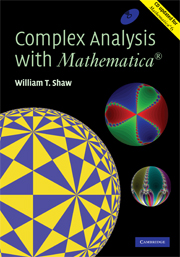Book contents
- Frontmatter
- Contents
- Preface
- 1 Why you need complex numbers
- 2 Complex algebra and geometry
- 3 Cubics, quartics and visualization of complex roots
- 4 Newton—Raphson iteration and complex fractals
- 5 A complex view of the real logistic map
- 6 The Mandelbrot set
- 7 Symmetric chaos in the complex plane
- 8 Complex functions
- 9 Sequences, series and power series
- 10 Complex differentiation
- 11 Paths and complex integration
- 12 Cauchy's theorem
- 13 Cauchy's integral formula and its remarkable consequences
- 14 Laurent series, zeroes, singularities and residues
- 15 Residue calculus: integration, summation and the argument principle
- 16 Conformal mapping I: simple mappings and Möbius transforms
- 17 Fourier transforms
- 18 Laplace transforms
- 19 Elementary applications to two-dimensional physics
- 20 Numerical transform techniques
- 21 Conformal mapping II: the Schwarz—Christoffel mapping
- 22 Tiling the Euclidean and hyperbolic planes
- 23 Physics in three and four dimensions I
- 24 Physics in three and four dimensions II
- Bibliograpy
- Index
5 - A complex view of the real logistic map
Published online by Cambridge University Press: 05 August 2014
- Frontmatter
- Contents
- Preface
- 1 Why you need complex numbers
- 2 Complex algebra and geometry
- 3 Cubics, quartics and visualization of complex roots
- 4 Newton—Raphson iteration and complex fractals
- 5 A complex view of the real logistic map
- 6 The Mandelbrot set
- 7 Symmetric chaos in the complex plane
- 8 Complex functions
- 9 Sequences, series and power series
- 10 Complex differentiation
- 11 Paths and complex integration
- 12 Cauchy's theorem
- 13 Cauchy's integral formula and its remarkable consequences
- 14 Laurent series, zeroes, singularities and residues
- 15 Residue calculus: integration, summation and the argument principle
- 16 Conformal mapping I: simple mappings and Möbius transforms
- 17 Fourier transforms
- 18 Laplace transforms
- 19 Elementary applications to two-dimensional physics
- 20 Numerical transform techniques
- 21 Conformal mapping II: the Schwarz—Christoffel mapping
- 22 Tiling the Euclidean and hyperbolic planes
- 23 Physics in three and four dimensions I
- 24 Physics in three and four dimensions II
- Bibliograpy
- Index
Summary
Introduction
You have already read about how to motivate the introduction of complex numbers by the need to solve quadratic equations, and have seen how to solve higher order polynomial equations both through ‘pen and paper’ analysis and with the help of Mathematica. In the previous chapter you looked at Newton—Raphson iteration. This is not the only way of defining an iterative solution method, and there is another approach called ‘cobwebbing’ which is the subject of this chapter.
You are now in a position to perform a basic investigation of some of the most fascinating topics in modern mathematics: period doubling and transitions to chaos. This topic can be introduced by considering simple quadratic or cubic functions. However, rather than solving a simple quadratic or cubic equation, you are now going to be concerned with applying a function over and over again, given a starting value. Under certain circumstances, this has the effect of finding the solutions to the original equation, but in other situations you will be led to the solutions of other polynomial equations. Hence the need for a complex view.
There are many good reasons for you to investigate these topics. First, you should appreciate the emergence of complexity and beauty from the iteration (repeated application) of a simple quadratic or cubic map. Second, you should appreciate that there is some value in doing ‘experimental mathematics’. However, here and elsewhere in this book we shall be concerned with appreciating the special role that complex numbers play.
- Type
- Chapter
- Information
- Complex Analysis with MATHEMATICA® , pp. 78 - 104Publisher: Cambridge University PressPrint publication year: 2006



